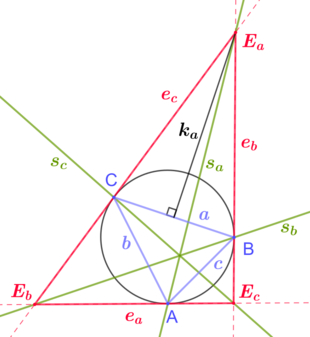Exsymmedian
The exsymmedians are three lines associated with a triangle. More precisely for a given triangle the exsymmedians are the tangent lines on the triangle's circumcircle through the three vertices of the triangle. The triangle formed by the three exsymmedians is the tangential triangle and its vertices, that is the three intersections of the exsymmedians are called exsymmedian points.
For a triangle [math]\displaystyle{ ABC }[/math] with [math]\displaystyle{ e_a, e_b, e_c }[/math] being the exsymmedians and [math]\displaystyle{ s_a, s_b, s_c }[/math] being the symmedians through the vertices [math]\displaystyle{ A, B, C }[/math] two exsymmedians and one symmedian intersect in a common point, that is:
- [math]\displaystyle{ \begin{align} E_a&=e_b \cap e_c \cap s_a \\ E_b&=e_a \cap e_c \cap s_b \\ E_c&=e_a \cap e_b \cap s_c \end{align} }[/math]
The length of the perpendicular line segment connecting a triangle side with its associated exsymmedian point is proportional to that triangle side. Specifically the following formulas apply:
- [math]\displaystyle{ \begin{align} k_a&=a\cdot \frac{2\triangle}{c^2+b^2-a^2} \\[6pt] k_b&=b\cdot \frac{2\triangle}{c^2+a^2-b^2} \\[6pt] k_c&=c\cdot \frac{2\triangle}{a^2+b^2-c^2} \end{align} }[/math]
Here [math]\displaystyle{ \triangle }[/math] denotes the area of the triangle [math]\displaystyle{ ABC }[/math] and [math]\displaystyle{ k_a, k_b, k_c }[/math] the perpendicular line segments connecting the triangle sides [math]\displaystyle{ a, b, c }[/math] with the exsymmedian points [math]\displaystyle{ E_a, E_b, E_c }[/math].
References
- Roger A. Johnson: Advanced Euclidean Geometry. Dover 2007, ISBN:978-0-486-46237-0, pp. 214–215 (originally published 1929 with Houghton Mifflin Company (Boston) as Modern Geometry).


